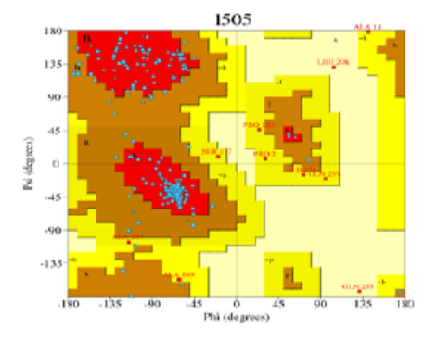


Indian Journal of Science and Technology
DOI: 10.17485/IJST/v17i28.1899
Year: 2024, Volume: 17, Issue: 28, Pages: 2889-2896
Original Article
S Sujatha1∗, R Rajini2
1Research Guide, Department of Biotechnology, Malankara Catholic College, Mariagiri, 629153
2Reg. No:18223082022001, Research Scholar, Manonmanium Sundaranar University Tirunelveli, Malankara Catholic College, Mariagiri
*Corresponding Author
Email: [email protected]
Received Date:06 June 2024, Accepted Date:02 July 2024, Published Date:22 July 2024
Objectives: Urolithiasis is a condition that occurs when the stones exit the renal pelvis and move onto the remainder of the urinary collecting system. Musa paradisiaca (L.) is a plant with high nutritive value and has been used for the treatment of various diseases including urolithiasis. The objective of the present study was designed to detect the receptor-ligand binding energy and interaction through a molecular docking from the bio-active compounds in an exudates of M. paradisiaca pseudo stem on urolithiatic causative protein named as glycolate oxidase receptor (PDB ID: 2RDU). Methods: In silico study especially molecular docking was performed using AutodockVina and the best confirmation between ligand and protein were selected using Lamarkaina Genetic Algorithm (LGA) and ligand protein interaction was visualized using PyMol viewer. Novelty: Totally three various bio-active compounds are elucidated named as Olean-12-ene-3 beta, 28-diol, Tricyclo[8.4.1.1(3,8)] hexadeca- 3,5,7,10,12,14-hexaene- 2,9-dione, anti and 2H-Pyran,2-(7-heptadecynyloxy)tetrahydro- from the exudate of experimental sample. Three phyto active compounds or secondary metabolites were used for the present prediction by docking. The present result of molecular docking clearly revealed that olean 12 -ene-3 beta, 28 diol is the best biologically effective ligand observed through a highest docking score (-7.2 k cal/mol) on glycolate oxidase receptor than other two ligand compounds. In conclusion the compound olean 12 -ene-3 beta, 28 diol could be act as a potential lead molecule for urolithiasis.
Keywords: Musa paradisiaca, Exudate, GCMS, Urolithiasis, AutoDock, PyMol Viewer
© 2024 Sujatha & Rajini. This is an open-access article distributed under the terms of the Creative Commons Attribution License, which permits unrestricted use, distribution, and reproduction in any medium, provided the original author and source are credited. Published By Indian Society for Education and Environment (iSee)
Subscribe now for latest articles and news.